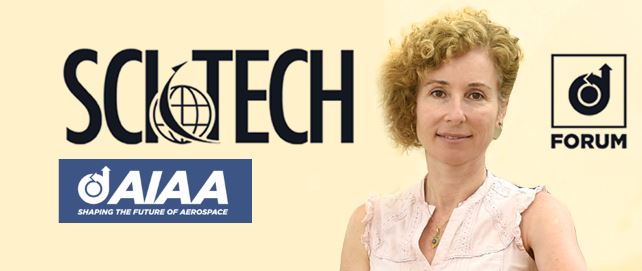חמישה מחקרים חדשים שנערכו על ידי פרופ’ רווה וצוותה במעבדה לאירואלסטיות פורסמו כחלק מפורום SciTech של המכון האמריקאי לאווירונאוטיקה ואסטרונאוטיקה (AIAA)
שלושה מהמחקרים הם על תכן, אנליזות וניסויי מנהרת רוח בכנף גמישה מאד. הניסויים ישמשו לתיקוף מודלים לכלים גמישים במיוחד. שני המחקרים האחרים עוסקים ב פלטפורמת ה- A3TB מל״ט ייעודי למחקרים ופיתוח טכנולוגיות אווירואלסטיות.
פורום AIAA SciTech הוא האירוע הגדול בעולם למחקר, פיתוח וטכנולוגית חלל. האירוע הווירטואלי של הפורום מתקיים בין התאריכים 11–15 ו- 19–21 בינואר 2021
חמשת המחקרים שנבחרו על ידי פורום AIAA :
1. An Experimental Benchmark of a Very FlexibleWing
The paper presents an experimental benchmark of a very flexible wing that is aimed at validation of analytical aeroelastic models of large deformations. For that goal, a wind tunnel wing model was designed for large deformations and manufactured. Wind-tunnel experiments include static and dynamic tests in which the wing deformations were tracked by a Motion Recovery System, the strains over the wingspan were recorded with a Bragg-grating fiber-optics system, and the aerodynamic loads were recorded by a force balance. The paper presents the wing design, linear and nonlinear dynamic and static aeroelastic analyses, calibration ground vibration tests and static loading tests, and the wind tunnel tests. The largest wingtip static deformation recorded in test was of 50% span. In the dynamic velocity-sweep tests, the wing became unstable at a velocity at which the wingtip deformation was approximately 25% of the span, and became stable again at higher speeds.
Read the article: http://bit.ly/39h4EmV
2. Nonlinear Aeroelastic Analysis of Very Flexible Wings Using the Modal Rotation Method
The paper presents a nonlinear, aeroelastic framework for the analysis of highly flexible wings accounting for large deformations, using a linear modal database. A nonlinear static analysis is conducted followed by a flutter analysis of the deformed shape. The wing deformations are computed with the recently presented Modal Rotation Method (MRM) that computes large structural deformations using spatial derivatives of the mode shapes defined as curvature modes. The MRM is coupled with an aerodynamic model, based on the rigid configuration, to compute static aeroelastic deformations. The method was extended to compute mode-shapes and frequencies of the deformed structure and to alter the unsteady aerodynamic matrices, to obtain a flutter solution of the deformed wing. Results were validated based on two experimental studies from the literature.
Read the article: http://bit.ly/3i3zumX
3. Flutter predictions for very flexible wing wind tunnel test
Two different nonlinear aeroelastic tool sets, SHARPy and the Modal Rotation Method (MRM), have been employed to predict and design a wind tunnel flutter test campaign of a very flexible wing, the Pazy Wing, as part of the 3rd Aeroelastic Prediction Workshop. The first method, SHARPy, uses geometrically exact beams coupled with an Unsteady Vortex Lattice, which is linearised about a deformed configuration, reduced by means of Krylov subspaces and analysed to compute the stability boundaries of the wing. The MRM is based on structural modal data, from either beam models or finite element models, coupled with a doublet-lattice aerodynamic model from ZAERO of the straight wing configuration. The excellent agreement between numerical and experimental data for structural-only and static aeroelastic analyses paves the way for predicting the stability boundaries of the Pre-Pazy wing with sufficient confidence for the safe design of a flutter wind tunnel test campaign.
Read the article: http://bit.ly/3s9xYo7
4. Design, Analysis, and Testing of the Active Aeroelastic Aircraft Testbed (A3TB) Platform
The paper presents the design, analyses, and initial flight testing results of the Active Aeroelastic Aircraft Testbed (A3TB), a 3D-printed aeroelastic demonstrator vehicle. The A3TB has the geometry of the Lockheed Martin Body Freedom Flutter [1]. It is a flying wing configuration, with a three meter span, 0.3 m chord, and a NACA0012 profile, controlled via eight trailing-edge control-surfaces. The A3TB structure is 3D printed in Nylon 12 with the printed wing short-segments connected by a thin carbon spar. The A3TB has a 2000 W electric engine and a pusher propeller, allowing for approximately 30 minutes of flight of the 10 kg airplane. 3D printing of the aircraft structure allows for easy and rapid design changes, and a relatively low unit cost of the experimental vehicle that is likely to break apart in flutter testing. The A3TB aerodynamic, dynamic, and aeroelastic characteristics were assessed with high fidelity finite element and computational fluid dynamics tools that can serve in future aeroelastic research and design.
Read the article: http://bit.ly/38sUSPu
5. Aeroelastic Analyses of the Free Flight of the Active Aeroelastic Aircraft Testbed (A3TB) Platform
This paper describes the aeroelastic analyses intended and the ones performed on the Active Aeroelastic Aircraft Testbed (A3TB), a low-cost design, flexible platform for aeroelastic research and technology demonstration developed at Technion Israel Institute of Technology. The aircraft is a 3D-printed, flying-wing configuration designed to be a modular experimental research platform, to demonstrate static and dynamic aeroelastic shape control that targets performance and stability goals. This aircraft contains basic features that are encountered in blended wing-body vehicles of the type of interest for precision agriculture. This is part of a collaborative effort between Technion and the University of Michigan on the study of UAVs capable of large-area coverage for crop monitoring. The studies detailed in this paper focuses on methods and solutions to evaluate the flutter behavior of such configurations and the potential impact on the flutter instability due to property fluctuations during the design and/or operations.
Read the article: http://bit.ly/35pkLh4









